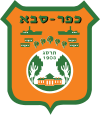Kfar Saba
Kfar Saba
| |
|---|---|
| Hebrew transcription(s) | |
| • ISO 259 | Kfar Sabaˀ |
| • Transleet. | Kfar Sava |
| Coordinates: 32°10′17″N 34°54′30″E / 32.17139°N 34.90833°ECoordinates: 32°10′17″N 34°54′30″E / 32.17139°N 34.90833°E | |
| Foondit | 1903 |
| Govrenment | |
| • Teep | Ceety (frae 1962) |
| • Mayor | Yehuda Ben-Hamo |
| Area | |
| • Total | 14.169 km2 (5.471 sq mi) |
| Population (2015)[1] | |
| • Total | 96,922 |
| • Density | 6,800/km2 (18,000/sq mi) |
| Name meanin | Grandfaither's veelage/Saba's veelage |
| Website | [http://www.kfar-saba.muni.il www.kfar-saba.muni.il (in Ebreu) ] |
Kfar Saba (Hebrew: כְּפַר סָבָא, lit. "Grandfaither's Veelage"), offeecially Kfar Sava, is a ceety in the Sharon region, o the Central Destrict o Israel. In 2015 it haed a population o 96,922.
History
[eedit | eedit soorce]
Kfar Saba (auncient Capharsaba) wis an important settlement durin the Seicont Temple period.[2][3] is mentioned for the first time in the writins o Josephus, in his accoont o the attempt o Alexander Jannaeus tae halt an invasion frae the North led bi Antiochus (Antiquities, beuk 13, chapter 15). Kfar Saba an aa appears in the Talmud in connection tae corn tithin an the Capharsaba sycamore fig tree.[2] The settlement wis likely named efter a body cried Sava, though this body's importance is no kent.[3]
Excavations on the site hae revealed the remains o a lairge Roman bathhoose. In the Byzantine periods the ruins o the bathhouse wur first convertit intae fish pools, an later intae some form o industrial installation.[4]
In 1596, an Arab veelage cried Kafr Saba existit at this place wi a population of 42 Muslim families.[5] In the 1870s it wis describit as "a mud veelage o moderate size wi mud-ponds aroond it an guid water in the wells o Neby Yemin, tae the east."[6] Modern Kfar Saba wis established in 1898 on 7,500 dunams o land purchased frae the Arab veelage.[7] Despite attractive advertisements in Jerusalem an Lunnon, attempts tae sell plots tae private individuals wur unsuccessful, as the land wis locatit in a desolate, neglectit aurie far frae ony ither Jewish settlement.[3] The Ottoman pasha o Nablus, tae whose govrenorate the land belanged, refused tae give biggin permits, therefore the first settlers wur forcit tae live in huts made o clay andstraw. They earned their livin bi growin almonds, grapes an olives. Maist o the manual laborers on the land wur peasants frae Qalqilya. Anerlie in 1912 wur permits gien an the settlers moved tae permanent hoosin.[3]
In the Palestine campaign o Warld War I, Kfar Saba wis on the front line atween General Allenby's Breetish Airmy an the Ottoman airmy, an wis destroyed. At the same time aboot a thoosan residents o Tel Aviv an Jaffa came toae live in the toun. They haed been forcibly deportit frae their hames bi the Ottomans.
Due tae the Jaffa riots o 1921 these deportees returned tae their oreeginal ceeties. In 1922 the oreeginal residents returned an in 1924 additional settlers joined them. In this period the cultivation o citrus fruit developed. The first elections for the local cooncil wur held.[8]
In the time o the Arab Revolt, in 1936-1939, as in the 1948 Arab-Israeli War, Kfar Saba's population suffered frae attacks bi Arabs frae the Arab veelage o Kafr Saba an ither veelages in the aurie. A short time afore the Israeli declaration o unthirldom these veelages wur taken in Operation Medina. In 1962 Kfar Saba wi awardit ceety status, wi heid o the local cooncil, Mordechai Surkis, becomin its first mayor.[9]
Internaitional relations
[eedit | eedit soorce]Twin touns an sister ceeties
[eedit | eedit soorce]Kfar Saba is twinned wi:
|
References
[eedit | eedit soorce]- ↑ "List of localities, in Alphabetical order" (PDF). Israel Central Bureau of Statistics. Retrieved 16 October 2016.
- ↑ a b The Origin of the Name Capharsaba Archived 2008-05-23 at the Wayback Machine Kfar Sava Municipal Council
- ↑ a b c d Vilnai, Ze'ev (1976). "Kefar-Sava". Ariel Encyclopedia. Volume 4. Israel: Am Oved. pp. 3790–96. (in Ebreu)
- ↑ According to Ayalon, 1982. Cited in Petersen, 2002, p.233
- ↑ Hütteroth, Wolf-Dieter; Abdulfattah, Kamal (1977), Historical Geography of Palestine, Transjordan and Southern Syria in the Late 16th Century, Erlanger Geographische Arbeiten, Sonderband 5. Erlangen, Germany: Vorstand der Fränkischen Geographischen Gesellschaft, p. 140
- ↑ C. R. Conder and H. H. Kitchener, The Survey of Western Palestine, II, p134.
- ↑ Pride and preservation, Jerusalem Post[deid airtin]
- ↑ History Archived 2009-11-26 at the Wayback Machine Kfar Saba Municipal Council (in Ebreu)
- ↑ Mordechai Surkis: Public Activities Knesset website
| Wikimedia Commons haes media relatit tae Kfar Saba. |


